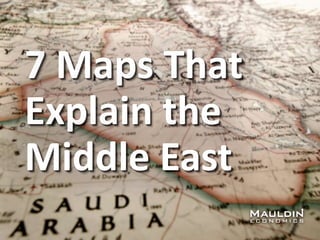
7 Maps That Explain the Middle East
- 1. 7 Maps That Explain the Middle East
- 2. The Middle East is obvious on the map…
- 3. The region, however, is far more complex than its borders.
- 4. The Middle East is the Arab core of the Muslim world. But thinking about the region as exclusively Arab excludes Turkey, Iran, and a very large Kurdish population.
- 5. Viewing it as exclusively Muslim would exclude the Jews, Christians, Druze, Yazidis, Zoroastrians, Bahai, and other religious groups in the region.
- 6. The idea of the Middle East has become quite vague, but in our view, it’s where perhaps the world’s most complex war is raging.
- 7. Now, let’s dig deeper into the demographics and history of the region to understand its complexity.
- 8. The Middle Eastern Population Is Concentrated in the Mountains
- 9. Mountainous terrain is typically less populated than lowlands due to obvious factors like ease of making a living.
- 10. Not so in the Middle East… since much of the lowlands lack water and offer a rather inhospitable quality of life.
- 11. As a result, most of the population clusters in the mountains of Iran, Iraq, and Turkey.
- 12. The Mountainous Northern Region Has a Wide Religious Diversity
- 13. Religious divisions are particularly important for understanding the Middle East .
- 14. Note the division between Sunnis and Shiites and the Christian and Jew mix.
- 15. But an understanding of these many religious factions is still not enough.
- 16. Ethnic Subgroups Complicate the Religious Fragmentation
- 17. The Kurds, for example, are largely Sunni Muslims. They are hostile to Arab Sunnis and Shiites.
- 18. The Druze are neither Muslim nor Christian, but can find themselves allied with either.
- 19. To understand the origins of this ethnic complexity, we need to look back to the times of the Ottoman Empire.
- 20. The Ottoman Empire Left the Old Middle East Highly Fragmented
- 21. The Ottomans dominated this region for centuries.
- 22. But unlike Muslims and Christians, they didn't use force to impose their religion on conquered nations.
- 23. The Ottomans, therefore, left the Middle East in a chaotic jumble of ethnic and religious groups after World War I.
- 24. Cultural differences resulted in endless battles in the region, but the aggression was limited to low-level conflicts.
- 25. Each group had the strength to survive, but lacked capabilities to conquer the others.
- 26. Plus, the mountainous terrain gave the advantage to the defender and made it difficult for conquerors to take full power.
- 27. The result has been inherent instability in the region.
- 28. The Europeans Divided the Middle East After WWI
- 29. After World War I, the victorious powers divided the Middle East region into entities that had never existed before.
- 30. The French took the northwest portion and consolidated it into one large state, Syria.
- 31. The British had a relationship with the Hashemite patriarch, Sharif Hussein, and they gave his elder son, Faisal I, the kingdom of Iraq.
- 32. What is most important, however, is to understand how artificial these entities were.
- 33. Now the Modern Middle East Can’t Hold Together
- 34. The point is that there is nothing natural about any of the Middle Eastern borders.
- 35. Some of the states were created on a more solid foundation than others, but they were all invented over the last century.
- 36. In this context, the rise of the Islamic State in the Middle East is not surprising, as almost all the states in this region were invented.
- 37. IS is just reshaping a shapeless area that external powers created and left to its own devices.
- 38. Record-low oil prices have pushed the Middle East into a serious economic crisis. Saudi Arabia’s economy, however, takes the most pain in the region. Before the end of this decade, the country could be broke… ISIS could be entrenched across the Middle East… and the cost of oil could be shockingly different from today. The special report from renowned economic analyst John Mauldin and world-leading geopolitical expert George Friedman reveals what the Saudi Arabian crisis means for the Middle East and the rest of the world. Grab your free copy Free Special Report
- 39. George Friedman provides unbiased assessment of the global outlook in his free publication, This Week in Geopolitics. Subscribe now and get an in-depth view of the forces that will drive events and investors in the next year, decade, or even a century from now. Subscribe here Subscribe
